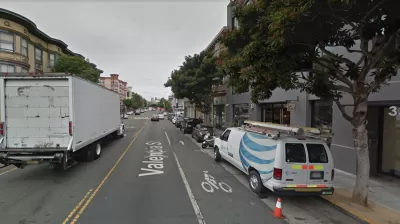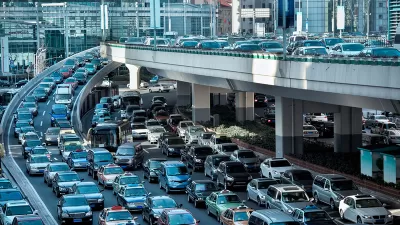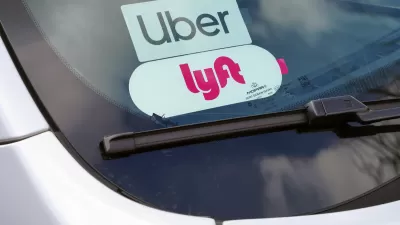The Lyft geofencing pilot in San Francisco will direct drivers to less busy side streets for pick ups and drop offs.

Transportation network company Lyft launched a new program in Sn Francisco last week that sets up a "geofence" to block pick up and drop offs on sections of busy streets.
Michael Toren reports that the first application of the geofencing technology has been implemented on Valencia Street in the Mission. The geofence requires drivers to move a certain number of its pick ups and drop offs on a specific section of busy street to a side street.
The prospect of TNCs limiting their operations along busy corridors is a new twist in an emerging and ongoing discussion about how space is allocated to cars—for instance, as ride hailing and Internet delivery services gain in popularity, some cities are rethinking the allocation of curb space to off-street parking. With this geofencing program, however, we see the other side of the same coin—ride hailing stepping aside to make priority for other modes of transportation.
Hat tip to Katie Pyzyk for sharing the article.
FULL STORY: Lyft moving pickups off parts of Valencia Street

Manufactured Crisis: Losing the Nation’s Largest Source of Unsubsidized Affordable Housing
Manufactured housing communities have long been an affordable housing option for millions of people living in the U.S., but that affordability is disappearing rapidly. How did we get here?

Americans May Be Stuck — But Why?
Americans are moving a lot less than they once did, and that is a problem. While Yoni Applebaum, in his highly-publicized article Stuck, gets the reasons badly wrong, it's still important to ask: why are we moving so much less than before?

Research Shows More Roads = More Driving
A national study shows, once again, that increasing road supply induces additional vehicle travel, particularly over the long run.

Which US Rail Agencies Are Buying Zero-Emissions Trains?
U.S. rail agencies are slowly making the shift to zero-emissions trains, which can travel longer distances without refueling and reduce air pollution.

San Diego School District Approves Affordable Housing Plan
The district plans to build workforce housing for 10 percent of its employees in the next decade and explore other ways to contribute to housing development.

Lawsuit Aims to Stop NYC’s ‘City of Yes’ Zoning Reforms
A lawsuit brought by local lawmakers and community groups claims the plan failed to conduct a comprehensive environmental review.
Urban Design for Planners 1: Software Tools
This six-course series explores essential urban design concepts using open source software and equips planners with the tools they need to participate fully in the urban design process.
Planning for Universal Design
Learn the tools for implementing Universal Design in planning regulations.
City of Moreno Valley
Institute for Housing and Urban Development Studies (IHS)
City of Grandview
Harvard GSD Executive Education
NYU Wagner Graduate School of Public Service
City of Cambridge, Maryland
Newport County Development Council: Connect Greater Newport





























